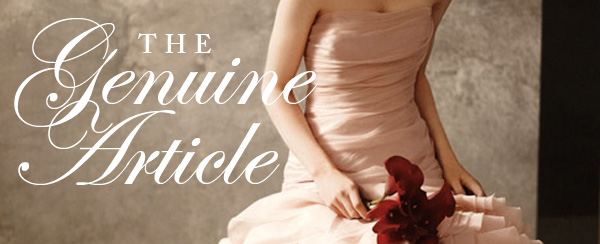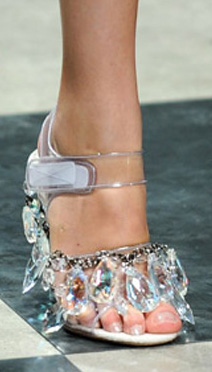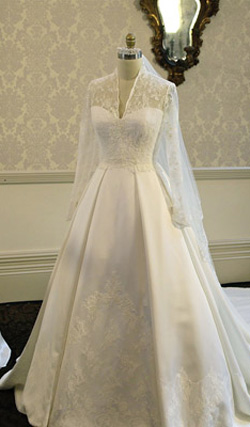Some Designers Say Their Work Deserves Copyright Protection; Others Say It Would Harm the Industry

Photo courtesy of Vera Wang and David’s Bridal
It was the fall of 2003 when Giacomo Corrado purchased his very first pair of “stripper shoes.” Strolling in the Soho neighborhood of New York City, Corrado spotted a divine pair of Prada pumps and just had to have them.
But Corrado wasn’t stocking his personal shoe collection; he was scouting the latest style trends for the Italian fashion house Fornarina, where he worked at the time as the company’s American chief executive officer.

Prada’s acrylic-heel “stripper shoe” concept was continued in its 2010 collection shown a Women’s Fashion Week in Milan. Photo by Giusseppe Cacace/AFP/Getty Images.
“Prada had done it again,” Corrado recalls. The shoes “were daring, sexy, absolutely innovative—a new trend—yet they reconciled with the most exquisite elegance: a blue patent leather sandal, ornate with gold edges, over the platform frame of the stripper’s shoe.”
Ladies who lunch met ladies of the pole in the ubiquitous sandals that were marketed in upscale stores across the country as the fashion du jour. But the design was hardly original. Exotic dancers in strip clubs from Las Vegas to Panama City, Fla., had been sporting the style for years and for hundreds of dollars less. But with the creative twist and imprimatur of one of the fashion world’s most celebrated labels, the stripper shoe turned into something else.
“The trend became ‘fashion,’ ” explains Corrado, an attorney now in private practice in New York City and an instructor at both the Fashion Institute of Technology and New York University’s School of Continuing and Professional Studies. “It inspired and guided nearly every shoe designer in the world, filling the shoe floor of every department store and boutique.”
Corrado says the popular trend wouldn’t have been able to spread if the original concept had been subject to the Innovative Design Protection and Piracy Prevention Act, a bill pending before Congress that for the first time would give fashion design copyright protection. Sponsored by Sen. Charles Schumer, D-N.Y., and supported by the Council of Fashion Designers of America, the IDPPPA is close to becoming law. But whether it’s good law or bad law is a matter of heated debate.
A MEASURE OF PROTECTION
For the designers council, copyright protection has been a long time coming, and the act represents both a compromise and a triumph. For years the nonprofit trade organization has lobbied for the same intellectual property protection afforded authors, songwriters and painters. Why should fashion designers be treated differently?
One reason, suggests Fordham University law professor Susan Scafidi, is the pervasive perception that fashion isn’t art, but clothing that serves a utilitarian purpose rather than an aesthetic one.
“Fashion [in the U.S.] is treated as less important—and it’s that cultural denigration of fashion that has kept protection from happening for a long period of time,” Scafidi says.
Scafidi has been working with the CFDA to change this viewpoint, and to get the IDPPPA passed. She’s testified before Congress and lectures on the topic across the country. Scafidi also heads Fordham’s Fashion Law Institute, one of the first centers of its kind in the world. Launched last fall and sponsored by the CFDA, the center provides legal services for designers, training for future lawyers and information on issues facing the fashion industry.
At the top of the center’s agenda: piracy.
“Countries around the world where you have substantial fashion industries all have protection,” Scafidi says. “France has full copyright protection—it’s the same for fashion designs as it is for works of literature, paintings, sculptures or anything else. Japan and India have 10 years of protection automatically. The U.S., which is a fashion leader, is strangely behind.”
The designers council and copyright supporters are struggling to play catch-up with the IDPPPA. The bill offers limited protection for all fashion and apparel, including clothes, handbags, belts and sunglasses, for a three-year period from the time the item is first seen in public. Designers who claim their work has been copied must prove that their design is wholly original, providing “a unique, distinguishable, nontrivial and nonutilitarian variation over prior designs”; that the offending design is substantially identical; and that the offender had an opportunity to see the design before it was released into the public. Damages are capped at $50,000 in the aggregate, or $1 per copy.
Previous language in the bill used a “substantially similar” standard to trigger copyright protection—a low threshold to which many in the industry objected. The latest version upgrades that standard to “substantially identical,” a more stringent hurdle utilized in trademark law and intended to place a higher burden on a complainant under the act.
Scafidi acknowledges the bill’s limitations but says she’s satisfied legislation is finally on the table. “This is not full copyright protection by any means, and it was never intended to be.”
An earlier version of the IDPPPA was introduced in 2006 by Rep. Bob Goodlatte, R-Va., and has been a lightning rod among industry players ever since.
The influential American Apparel & Footwear Association, a 700-member-strong organization, initially opposed copyright protection. The AAFA thought the original version of the bill was too broad and exposed designers to frivolous copyright claims from competitors. After a year of negotiations, the designers council and apparel association reached an agreement in the form of the IDPPPA, and Schumer introduced a bill signed onto by both sides. Even then, the legislation went through more modifications, and it was reintroduced two more times before the Senate Judiciary Committee sent it for a full vote at the end of the last congressional session.

Chelsea Clinton’s wedding dress, designed by Vera Wang. Photo: Getty Images
IT’S ALL BEEN DONE BEFORE
Not consulted during the dealmaking was the California Fashion Association, which claims more than 350 members, including some of the biggest names in fashion merchandising—Guess Inc. and Forever 21. The CFA has aggressively opposed the IDPPPA and any form of copyright protection for fashion.
“Everything in fashion was done before,” says Ilse Metchek, president of the CFA. “Nothing you can design that is made from a pattern—with the exception of costumes—hasn’t been done before. These designers who are screaming about their designs, you can go back years and find the same designs.”
Metchek points to early 20th century styles with shapes and detailing such as square shoulders that she says have been replicated and claimed as original by modern designers. Metchek also objects to what she calls the confusing wording of the IDPPPA and says the CFA should have been included in the debate.
“What is ‘substantially identical?’ What does ‘substantially’ mean?” Metchek asks. “Leaving that judgment to a judge, a nonfashion person who doesn’t understand the business or industry history, is dangerous. It’s ridiculous. It will clutter up the courts—and it will be very sad how many cease-and-desist letters will fly, and all the settlements and litigation.”
Despite the CFA’s opposition, the act has the support of both California senators. Democratic Sen. Barbara Boxer is backing the bill, says her spokesman, Zachary Coile, because it represents a “carefully negotiated compromise.”
The IDPPPA “strikes the right balance between protecting our designers from theft and piracy, and preserving innovation in our apparel industry,” he says.
With 10 Senate co-sponsors, including four Republicans, Scafidi is confident the bipartisan legislation should “go like greased lightning” through Congress this term.
“It’s a ‘narrowly tailored’ bill for a perfect fit,” Scafidi quips.
But instead of seeing a perfect fit, opponents of the Innovative Design Protection and Piracy Prevention Act predict a fashion disaster. They criticize the bill as too vague and ineffective, and they say it sets a dangerous precedent. Such is the world of style, where opinion and competing interests can make or break a designer—or, in this case, design legislation. The lobbying and debating continue, even as the IDPPPA wends its way through Congress.
“This bill is being supported by legislators who wear polyester suits and have no idea what fashion really is,” Corrado says. “It’s a step back rather than a step forward.”
 Kate Middleton’s Dress, designed by Sarah Burton of the Alexander McQueen fashion house, at her April 29th wedding. Photo: Boris Roessler/DPA/Corbis
Kate Middleton’s Dress, designed by Sarah Burton of the Alexander McQueen fashion house, at her April 29th wedding. Photo: Boris Roessler/DPA/Corbis
FROM THE CATWALK TO THE STRIP MALL
It’s the kind of contretemps you’d expect on an episode of Project Runway; but this debate is pitting design houses, lawyers and academics against each other in framing the future of fashion merchandising.
“Designers are very emotional about their work because they’re artists,” Corrado notes.
That’s one area where Corrado and Metchek disagree: fashion as art. Metchek argues that copying is OK because fashion design doesn’t deserve the same protection as, say, paintings or sculptures.
“It’s not art; it has never been art—it’s a craft,” Metchek asserts. “And it’s not piracy; it’s a trend.”
Metchek describes the replication of styles as part of a natural evolution of fashion, a cycle she says benefits high-end designers.
“You think people buy Prada because it’s well-made and sits well?” Metchek asks. “No. They buy it because it’s Prada. So if one of their knockoffs becomes a nationwide trend, it’s good for their business.”
Designers Anna Sui, Gwen Stefani and Diane von Furstenberg would likely beg to differ. All three, along with labels such as Anthropologie and Trovata, have sued Forever 21, a retail powerhouse and accused fashion pirate, alleging trademark infringement for stealing design patterns used on their products. According to dozens of complaints and cease-and-desist letters, the Los Angeles-based company is yanking styles—from patterns to buttons—straight from the runways and replicating them on their store racks. This so-called fast fashion has changed the infringement landscape, turning copycat designs into a business model.
Forever 21 in particular is considered an equal opportunity poacher, treating lawsuits like any other operating cost and drawing “inspiration” from both smaller designers and the hottest brands in the industry, according to legal experts and designers.
Virginia Johnson, a Toronto-based textile designer, was shocked to find her distinctive, colorful prints on a skirt at Forever 21.
“It had never happened before,” Johnson says. “It’s happened since a couple of times with smaller companies. It was kind of surprising and strange.”
Johnson’s lawyer contacted Forever 21 with proof she had created the artwork featured on the skirts in its stores. Forever 21 agreed to settle, telling Johnson that $40,000 worth of the skirts had sold, and that its normal design fee is 10 percent of sales. The two sides eventually compromised at $5,500, and the offending skirt was discontinued.
“They were very straightforward dealing with it. They didn’t try to hide it,” Johnson says.
Complaints by Johnson, Sui, Stefani and von Furstenberg were based on the trademark protection afforded to original prints and graphics on clothes and fabrics. As artworks, these graphics carry protections unavailable to other fashion designs.
After her Forever 21 experience, Johnson now registers all the artwork on her fabric with the Library of Congress. But it still isn’t fail-safe.
“Someone only has to alter it slightly to escape the copyright, so sometimes it’s hard to prove,” Johnson says. “I feel small designers have to be free to not worry about whether their designs will be stolen or not, so they can feel good about putting things out there. It’s so easy for a big company to come and rip them off.”
 A team from Woman’s Day Australia spent a combined 130 hours over the weekend to replicate the Kate dress, unveiled May 2. Photo: Mike Flokis/Getty
A team from Woman’s Day Australia spent a combined 130 hours over the weekend to replicate the Kate dress, unveiled May 2. Photo: Mike Flokis/Getty
POINT-COUNTERPOINT
But how will the act protect designers from international predators like the Chinese manufacturers that specialize in knockoffs and are more difficult to pursue? According to Metchek, international labels Zara and H&M have also refined the art of making millions off others’ intellectual property.
IDPPPA supporters say the bill can’t solve all problems, but it gives designers a good chance of retaining profits from their intellectual property. Steven Kolb, executive director of the Council of Fashion Designers of America, says copycat designs devalue designers’ ability to make money by beating their product to store shelves and saturating the marketplace.
Kolb points to two high-profile examples: In fall 2010, A.B.S. by Allen Schwartz famously announced it would copy Chelsea Clinton’s five-figure Vera Wang wedding gown, just months after her New York nuptials, and sell the frock for a fraction of the cost. Similarly, Narciso Rodriguez’s 1996 wedding dress for Carolyn Bessette Kennedy was cloned by designers all over the world. Rodriguez has said millions of copycat designs were sold at the retail level; he sold 40.
“Why shouldn’t [Wang or Rodriguez] own the design [they] came up with?” Kolb asks. “Why the next day can someone steal it and sell it? Why can’t designers have the opportunity to enter into licensing agreements or have a lower-priced line themselves?”
Metchek scoffs at the notion that designs like Wang’s should be protected by copyright. “Vera Wang made a strapless wedding dress with a ruffled skirt—maybe she set a trend, but is that new?” Metchek asks.
That’s pretty much the sentiment of University of Virginia law professor Christopher Sprigman, who studies counterfeiting and intellectual property. Sprigman and UCLA law professor Kal Raustiala have publicly opposed any form of copyright protection for fashion design—a position detailed in their upcoming book, The Piracy Paradox. Sprigman blames overzealous intellectual property protection for the problems in other industries, and he warns that the IDPPPA could ruin the fashion business.
“If we didn’t allow copyrights, there’d be a lot less damage,” Sprigman argues. “The reason the music industry is imploding is musicians think copyrights can solve their problems. The result is their business shrunk by about 80 percent. That’s what overreliance on copyright can get you.”
Sprigman points to the food and fashion industries as areas that thrive in a world where copyright doesn’t apply. Like Metchek, he argues that the fashion industry gets richer when designs turn over quickly. Sprigman believes copyright protection would thwart this process.
Under Sprigman’s analysis, fast-fashion retailers are the engines of change in the industry, moving trends from the runway to the streets. These Robin Hoods of ready-to-wear are making fashion affordable and accessible, creating a rapid turnaround of trends and prompting designers to quickly create the next “it” look, enriching everyone in the process.
Kolb and his constituents see the situation differently. “We’re trying to protect someone’s creative work,” he says. “It’s the elements and investment that go into making clothes that take a lot of money and a lot of time and belong to someone. It’s a little bit like R&D—and for designers to have that hijacked is really unfair.”
‘PIRATES AND PREACHERS’
There are clear losers if the IDPPPA is passed, specifically the mass-market retailers who have built multimillion-dollar empires based on cloned fashion. But opponents of the act say everyone along the fashion spectrum will suffer.
“There’s always a danger in restricting commerce,” fashion lawyer Corrado warns. “In this case, big groups will be able to bully smaller designers just by the threat of litigation. It will be very difficult for kids I teach at FIT to protect their own designs against the giants.”
Sprigman agrees, saying, “You’re going to start seeing what you see in a lot of other industries: Lawyers being used as a barrier to entry, and people at the top trying to cement their place at the top.”
Scafidi has heard all the rhetoric and is ready to move on. After the years of work put into the IDPPPA, she says the only people still against it are “pirates and preachers.” She doesn’t believe the bill will cause an increase in lawsuits and says its primary goal is to cause fashion copycats to think twice before cloning.
“The careful construction of the bill is to make it almost self-executing,” Scafidi asserts. “The clear copying cases won’t end up in litigation; the ones that do go to court are the ones that are borderline or close calls.”
Scafidi and the Council of Fashion Designers of America insist that more protection will lead to more creativity. And designers like Johnson say that when it comes to unique fashion, designers deserve protection.
“I just think businesses should hire their own teams to come up with original designs,” Johnson says. “You can still be trendy without stealing people’s ideas.”



